The Force Field File¶
This required file must contain the force field parameters and the MM potential for each kind of MM interaction. Although predefined force field files (AMBER and SYBYL) are provided with ADF, these force field files can be customized. For example, one may want to change a particular force constant, or one may need to introduce a new atom type, for instance a transition metal. This section provides a detailed description of the force field file.
General Notes¶
Format¶
The force field file is keyword driven with each key block defining parameters for each molecular mechanics interaction type such as bond types, angle types, torsion types, ...etc. The key block begins with the keyword, such as “BONDS”.
The lines that actually contain the parameters are sandwiched between two lines that contain “========”. The lines between the keyword and the first line containing “========” are not read by the program. These lines are intended for the user to define the columns as shown below. There can be as many lines between the keyword and the first ‘=====’ as needed.
Example:
BONDS
Atoms pot K ro Notes
i - j type (kcal/molA^2) (Ang)
================================
...
CA CA 1 938.0 1.400 amber95
CT CT 1 620.0 1.526 amber95
...
===============================
Force Field Atom types¶
The force field atom types are the labels given to each atom in the real system that is used to generate the molecular mechanics portion of the QM/MM potential. These are separate from the atomic fragment types used by ADF for the electronic structure calculation. It is important to realize that QM atoms will have both an atomic fragment type and a force field atom type.
There are some limitations to the force field label types that the user can specify:
- Labels can be a maximum of four characters long, with no spaces.
- The atom types are case sensitive.
- They can contain letters, numbers and other characters except ‘,’ ‘.’ or ‘=’ and tabs.
Example of atom types that are not compatible with the program: C.3, C 3, C=3, C_sp3, *
Examples of atom types that are correct: C_3, C3, Csp3, and C*
Wild Cards¶
Wild cards can be specified with the asterisk, ‘*’. Wild cards can be specified for angles, torsions and out-of-plane bends. Please refer to the specific sections for the limitations.
CAUTION: When using wild cards, place the wild cards at the beginning of the data section, beginning with the parameters with the most wild cards and ending with those that posses the least wild cards.
Example:
| C_3 | 100.310 | 111.000 | two wild cards | ||
| C_3 | C_3 | 100.310 | 111.000 | one wild card | |
| C_2 | C_3 | C_3 | 100.310 | 111.000 | no wild cards |
If this ordering is not followed, then the wild card parameters will over-ride the specific parameters.
Dummy Atoms¶
If the QM program uses dummy atoms, they are specified ‘Xx’ or ‘XX’. The program will automatically remove dummy atoms from the non-bonded pair list. Please note that if the user specifics bonds to the dummy atom in the connection table, the program will look for the appropriate parameters in the force field file. The program does not filter out this possibility because sometimes it is useful to specify MM bonds to dummy atoms).
Miscellaneous Notes¶
- Do not remove the ‘======’ separator lines.
- Units are in kcal/mol, Angstroms, degrees, amu unless otherwise specified
- Sections can be in any order; i.e. BENDS can come before BONDS.
- All keywords are case sensitive and most are in ALL-CAPS
- Input is all free format
- Blank lines will be ignored
- Comment lines can be added to parameter data sections by beginning the line with the ‘#’ symbol.
Example:
H H 1.0080
HC H 1.0080
# example of comment line denoted with # mark.
H1 H 1.0080
H2 H 1.0080
4.3 A (partial) Example File
In this section we provide an example force field file to illustrate the format of the file. Only a limited number of parameters are included. A detailed description of each section of the force field file is provided in the next section.
FORCE_FIELD_SETTINGS
================================
ELSTAT_1-4_SCALE 1.0000
VDW_1-4_SCALE 1.0000
VDW_DEFAULT_POTENTIAL 1 (1:6-12 2:exp-6 3:exp purely repulsive)
DIELECTRIC_CONSTANT 1.000
================================
MASSES & ATOM LABELS
-----------------------------------
force_field atomic
atom_type symbol mass NOTES
==========================
C_3 C 12.0110 sp3 hybridized carbon
C_2 C 12.0110 sp2 hybridized carbon
C_1 C 12.0110 sp1 hybridized carbon
C_ar C 12.0110 aromatic
N_3 N 14.0070
N_2 N 14.0070
O_3 O 15.9990
==========================
BONDS Ebond = 0.5*K(r-ro)**2
--------------------------------------
Atoms pot
i - j type K R NOTES
==========================
C_2 C_2 1 1340.00 1.335 WHITE_77
C_2 C_3 1 639.00 1.501 WHITE_75
C_3 C_3 1 633.60 1.540 *
C_3 N_2 1 760.20 1.440 *
==========================
BENDS Ebend = 0.5*k(a-ao)^2
------------------------------------
Atoms pot
i - j - k type K theta NOTES
===================================
* C_2 * 1 78.79 120.00 WHITE_77
* C_3 * 1 65.66 109.50 WHITE_77
* C_ar * 1 78.79 120.00 *
C_ar C_2 N_2 1 131.31 120.00 *
C_3 C_3 C_ar 1 78.79 109.50 *
===================================
TORSIONS
--------------------------------------------
Atoms pot
i - j - k - l type k per NOTES
============================================
* C_2 C_2 * 2 12.5000 -2.0
* C_1 C_3 * 2 0.0000 1.0
C_2 C_2 C_3 * 2 0.1260 -3.0
C_3 C_2 C_3 * 2 0.1260 3.0
H C_2 C_3 * 2 0.2740 3.0
* C_ar C_ar C_ar 2 2.3500 -2.0
* C_2 C_3 C_2 2 0.1260 3.0
* C_2 C_3 C_3 2 0.1260 3.0
C_3 C_3 C_3 C_3 0 0.5000 3.0 no torsion potential
C_2 C_2 C_3 C_2 2 0.1260 -3.0
C_3 C_3 N_2 C_2 1 0.5000 4 180.0 This and the next 3 lines
& 0.1500 3 180.0 are part of a multi-component
& 0.5300 1 0.0 Fourier potential
C_3 C_3 C_2 N_2 1 0.1000 4 0.0
& 0.0700 2 0.0 '&' is a continuation marker
============================================
OUT-OF-PLANE
-------------------------
Atoms pot
i - j - k - l type K NOTES
=========================
* * C_2 * 2 480 TRIPOS_85
* * N_2 * 2 120 TRIPOS_85
H H N_2 C_3 2 120 TRIPOS_85
C_3 H N_2 * 2 120 TRIPOS_85
=========================
VAN DER WAALS
atom(s) Emin Rmin gamma NOTES
=================================
C_3 0.1070 3.4000 12.00
C_2 0.1070 3.4000 12.00
C_ca 0.1070 3.4000 12.00
C_ar 0.1070 3.4000 12.00
C_1 0.1070 3.4000 12.00
N_3 0.0950 3.1000 12.00
N_2 0.0950 3.1000 12.00
N_2 - N_2 2 0.0950 3.1000 12.00 purely repulsive potential for this pair
=================================
type charge(e) NOTES
================
OW -0.82 TIP3P water model
HW 0.41 TIP3P water model
================
Section by Section Description¶
FORCE_FIELD_SETTINGSKey block (required) This key block specifies various global options for the force field file, mostly concerned with the treatment of the non-bonded potentials.
FORCE_FIELD_SETTINGS ================================ ELSTAT_1-4_SCALE 0.5 VDW_1-4_SCALE 0.5 VDW_DEFAULT_POTENTIAL 1 (1:6-12 2:exp-6 3:exp purely repulsive) DIELECTRIC_CONSTANT 1.000 ================================
ELSTAT_1-4_SCALE & VDW_1-4_SCALE- Most force fields scale the non-bonded interactions by a factor of 0.5 if the atoms are the terminal atoms of a defined torsion. This scaling factor, which is termed the 1-4 scaling factor, can also be different for the electrostatic potential and for the Van der Waals potentials and thus they are separately defined in the input.
VDW_DEFAULT_POTENTIALThis keyword defines what kind of potential is used for the non-bonded van der Waals interactions. The potential types have been assigned integer values as defined in the following table.
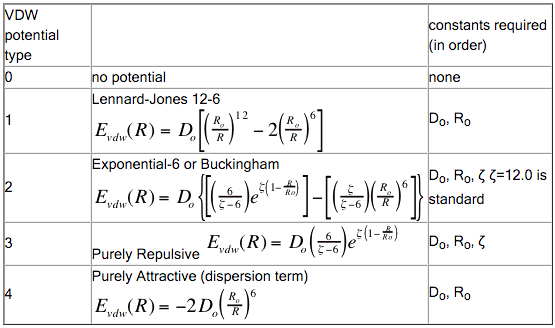
DIELECTRIC_CONSTANT- Default = 1.00 This defines the dielectric constant used for the calculation of the electrostatic interactions. For example, 1.00 = vacuum and 80 is that of bulk liquid water. Currently, only a constant dielectric has been implemented.
BONDSKey block (required) This key block specifies the potential type and parameters for each kind of MM bond stretching interaction. An example is given below.
BONDS Atoms pot K ro NOTES i - j type (kcal/molA^2) (Ang) =============================== CA CA 1 938.0 1.400 amber95 CT CT 1 620.0 1.526 amber95 HC Zr 0 0.0 no potential found ===============================
The first two columns are the atom types (up to four characters long) and the third column is an integer specifying the potential type.

BENDSKey block (required) This key block specifies the potential type and parameters for each kind of MM bond angle interaction. An example is given below.
BENDS Atoms pot k ao NOTES i - j - k type (kcal/mol) deg ================================= * CA * 1 70.00 120.00 example of wild card * CA CA 1 126.00 120.00 CA CA N2 1 140.00 120.10 amber95 N2-CA-CM CA CA CT 1 140.00 120.00 amber95 =================================
The first three columns specify the atom types and the fourth column is an integer specifying the potential type. The angle bend potential types are described in the table below with the additional constants required.

Notice that wild cards can be specified for both terminal positions of the bend or just one as in the example above. It is important that the parameters be ordered from the least specific (those containing the most wild cards) to the most specific parameters.
TORSIONSKey block (required) This key block specifies the potential type and parameters for each kind of MM bond torsion interaction. For the bond stretching and bending potentials, only one potential has to date been implemented since both AMBER and SYBYL both use simple harmonic potentials. However, AMBER and SYBYL use different functional forms to represent the torsion potentials, each with their own set of parameters. The AMBER and SYBYL torsional potentials used in this program are defined in the table below.
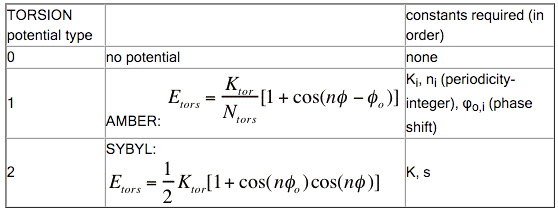
Notice that the two potentials have a different number of parameters. For example, when the program reads ‘potential type’ number 1, it will expect three parameters Ki , ni , \(\phi\)o,i . Further notice that the AMBER torsional potential is a sum of Fourier components (this is what the index i refers to).
Below is an example of the TORSIONS key block, made up of AMBER force field types.
TORSIONS Atoms pot per. shift i - j - k - l type k n to NOTES =================================================== * CV NB * 1 2.4000 2 180.0 JCC,7,(1986),230 * CW NA * 1 1.5000 2 180.0 JCC,7,(1986),230 & 0.1000 3 0.0 C N CT C 1 0.2000 2 180.0 N CT C N 1 0.4000 4 180.0 & 1.3500 2 180.0 & 0.7500 1 180.0 CT CT N C 1 0.5000 4 180.0 ===================================================
Most AMBER torsion potentials are not specific to all four atoms i-j-k-l, but only on the central two, j-k. Wild cards are specified with the ‘*’ symbol as illustrated above. Again, the ordering is important. The parameters should be ordered from least specific (those containing the most wild cards) to most specific. The AMBER torsion potential can be composed of more than one Fourier component for a single torsion potential. Additional Fourier components are specified with the ‘&’ continuation symbol as in the example above. At the moment, up to 6 Fourier components are allowed. Notice that the individual components need not be specified in any particular order. In the above example key block, there are only 5 torsional potentials defined, not 8. Two of the potentials are composed of more than one Fourier component as indicated by the ‘&’ continuation line. Below is an example of the TORSIONS key block for the SYBYL force field. Notice that the potential types are all ‘2’. There are fewer parameters and no multi component potentials. Also, some potentials are defined with two or only one wild card.
TORSIONS ------------------------------------------- Atoms pot i - j - k - l type k per NOTES =============================================== * C_ar S_3 * 2 1.0000 3.0 * * S_3 S_3 * 2 0.0000 2.0 EXP C_2 C_2 C_3 * 2 0.1260 -3.0 WHITE_77 C_3 C_2 C_3 * 2 0.1260 3.0 WHITE_77 H C_2 C_3 * 2 0.2740 3.0 * * C_ar C_ar C_ar 2 2.3500 -2.0 * * C_2 C_3 C_2 2 0.1260 3.0 WHITE_77 * C_2 C_3 C_3 2 0.1260 3.0 WHITE_77 * C_2 C_3 H 2 0.2740 3.0 WHITE_77 * C_3 C_3 H 2 0.3200 3.0 MC_88 O_2 C_2 C_3 C_3 2 0.7000 -3.0 JL_ES_ O_co C_2 C_3 C_3 2 0.7000 -3.0 MAC_1 C_2 C_3 C_3 C_2 2 0.0400 3.0 WHITE_77 C_2 C_3 C_3 C_3 2 0.1260 3.0 WHITE_77 ===============================================
One can also mix different potential types within the same force field file, as illustrated below. In this example, three are three potentials. The first two are SYBYL type potentials whereas the last one is a multi component AMBER potential.
H C_2 C_3 * 2 0.2740 3.0 * C_ar C_ar C_ar 2 2.3500 -2.0 N CT C N 1 0.4000 4 180.0 & 1.3500 2 180.0 & 0.7500 1 180.0
OUT-OF_PLANEKey block (required) This key block specifies the potential type and parameters for each kind of MM out of plane bend. This potential is sometimes referred to as the inversion potential or improper torsions (depending on the force field). The potential types currently supported are provided in the table below.
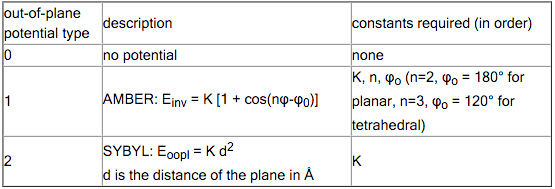
An example of the key block for the AMBER type potentials is given below. It is important to realize that the atom k is the atom k is the central atom. (We have adopted the somewhat odd standard of AMBER in this respect).
OUT-OF-PLANE -------------------------- Atoms pot i - j - k - l type K to NOTES ============================================ * * CA H4 1 1.10 180.0 bsd.on C6H6 nmodes * * CA H5 1 1.10 180.0 bsd.on C6H6 nmodes * O2 C O2 1 10.50 180.0 JCC,7,(1986),230 * N2 CA N2 1 10.50 180.0 JCC,7,(1986),230 * CT N CT 1 1.00 180.0 JCC,7,(1986),230 CK CB N* CT 1 1.00 180.0 ============================================
VAN DER WAALSKey block (required) This key block specifies the potential type and parameters for each kind of MM van der Waals interaction between two atoms. A sample key block is shown below:
atom(s) type emin rmin alpha NOTES ==================================== CA -.0860 3.81600 12.00 amber95 HA -.0150 2.91800 12.00 amber95 Ni - HA 2 -.0480 2.7 12.00 NOTE potential type Ni - CA D -.0480 2.7 12.00 default potential ====================================
The van der Waals key block is somewhat different than the previous key blocks, because generally not every atom pair is defined with its own parameters. Rather, the parameters are assigned on a per atom basis and then special combination rules are used to construct the parameters for each atom pair combination. For this reason, a default potential type is defined in the FORCE_FIELD_SETTINGS key block.
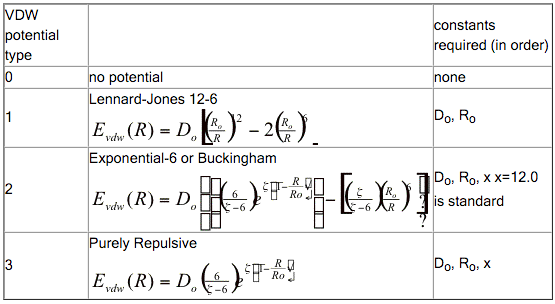
For each type of van der Waals interaction, the program first scans the key block for pair specific parameters. For pair specific potentials, the default potential type can be replaced by any of the available potentials. The three sample lines below specify pair-specific potentials. The two atom types must be separated by a hyphen with spaces between the hyphen and the atom type. Following the specification of the atom pair, the potential type is defined. If D or d is specified here, then this means to use the default potential type. Following the potential type are the parameters needed for that potential type (see above table).
CA - CA 1 0.0860 3.81600 12.00 amber95 Ni - HA 0 Ni - CA D 0.0480 2.7 12.00 default potential type
If a pair specific parameter can’t be found, then the program looks for individual atom parameters corresponding to each of the atom types in the pair. The pair specific parameters are then constructed from combination of the two individual atom parameters using the following combination rules:
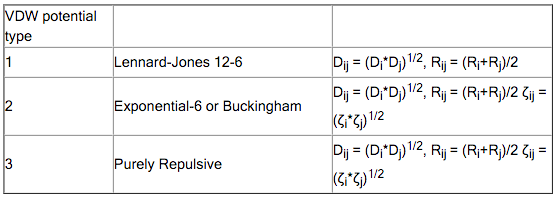
When individual atom parameters are not used, no potential type is specified since the default potential type is always used. An example is given below.
CA 0.0860 3.81600 12.00 amber95 HA 0.0150 2.91800 12.00 amber95
The ability to define pair specific parameters is especially useful for those force fields that have different combination rules than used in the program. For example, Jorgensen’s TIP3P water force field uses geometric averages for both Dij and Rij .
MASSES & ATOM LABELSKey block (required) This key block specifies the default masses for each MM atom type and the element label for each MM atom type. In an ADF QM/MM run, the element label defined for each atom type is the label used for printing out to the LOGFILE. This allows one to easily cut and paste the generated coordinates to a molecule viewing program without having to go in and changing all of the “CT”s to “C”s.
A sample key block is shown below:
MASSES & ATOM LABELS ===================================== Ni Ni 58.70 CM C 12.011 CA C 12.011 CT C 12.011 HC H 1.0079 HA H 1.0079 =====================================
The first column is the MM atom type, the second is the label used for printing and the third column is the mass of the atom type. The atoms do not have to be specified in any particular order.
CHARGESKey block (optional) This key block specifies the parameters for the charges on the atoms by atom type. To date only the initial charge is available, however if some sort of charge equilibration scheme was introduced the parameters would go here. NOTE: initial charges can also be specified on a per atom basis in the MM INPUT file.
CHARGES atoms initial label charge ======================== OW -0.8 HW 0.4 ========================